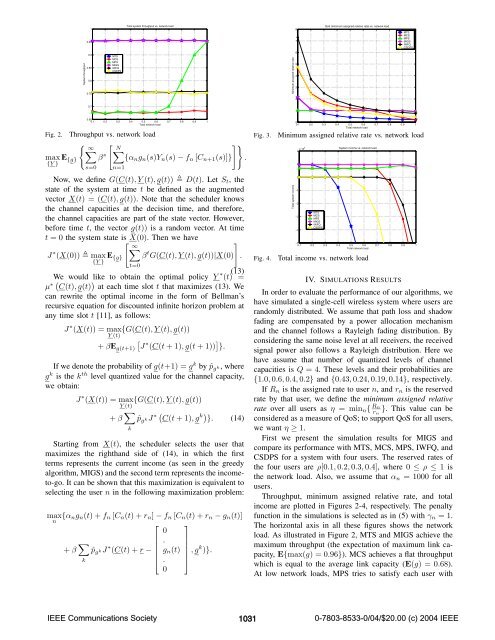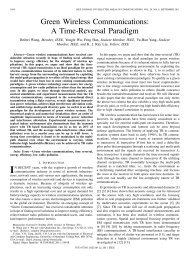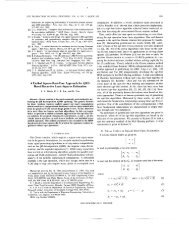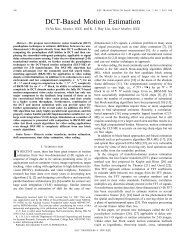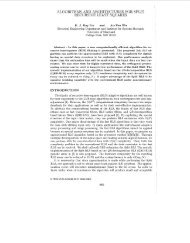0.1 0.2 0.3 0.4 0.5 0.6 0.7 0.8 0.9 110.95Total system throughput vs. network load87QoS (minimum assigned relative rate) vs. network loadMTSMCSMPSMIGSIWFQCSDPSSystem throughput0.90.850.80.75MTSMCSMPSMIGSIWFQCSDPSMinimum assigned relative rate654320.710.65Total network loadFig. 2. Throughput vs. network load{ ∞[max E ∑ N]}∑{g} β s {α n g n (s)Y n (s) − f n [C n+1 (s)]} .{Y }s=0 n=1Now, we define G(C(t),Y(t),g(t)) D(t). LetS t ,thestate of the system at time t be defined as the augmentedvector X(t) =(C(t),g(t)). Note that the scheduler knowsthe channel capacities at the decision time, and there<strong>for</strong>e,the channel capacities are part of the state vector. However,be<strong>for</strong>e time t, the vector g(t)) is a random vector. At timet =0the system state is X(0). Then we have[ ∞]J ∗ (X(0)) max E ∑{g} β t G(C(t),Y(t),g(t))|X(0) .{Y }t=0(13)We would like to obtain the optimal policy Y ∗ (t) =µ ( ∗ C(t),g(t) ) at each time slot t that maximizes (13). Wecan rewrite the optimal income in the <strong>for</strong>m of Bellman’srecursive equation <strong>for</strong> discounted infinite horizon problem atany time slot t [11], as follows:J ∗ (X(t)) = max {G(C(t),Y(t),g(t))Y (t)[+ βE g(t+1) J ∗ (C(t +1),g(t + 1)) ] }.If we denote the probability of g(t+1) = g k by ˆp g k, whereg k is the k th level quantized value <strong>for</strong> the channel capacity,we obtain:J ∗ (X(t)) = maxY (t) {G(C(t),Y(t),g(t))+ β ∑ kˆp g kJ ∗ ( C(t +1),g k) }. (14)Starting from X(t), the scheduler selects the user thatmaximizes the righthand side of (14), in which the firstterms represents the current income (as seen in the greedyalgorithm, MIGS) and the second term represents the incometo-go.It can be shown that this maximization is equivalent toselecting the user n in the following maximization problem:max {α ng n (t)+f n [C n (t)+r n ] − f n [C n (t)+r n − g n (t)]n⎡ ⎤0+ β ∑ .ˆp g kJ ∗ (C(t)+r −⎢ g n (t)⎥k⎣ . ⎦ ,gk )}.0Fig. 3.Fig. 4.00.1 0.2 0.3 0.4 0.5 0.6 0.7 0.8 0.9 1Total network loadMinimum assigned relative rate vs. network loadTotal system incomeSystem income vs. network load10510−1−2MTSMCS−3MPSMIGSIWFQCSDPS−4−50.1 0.2 0.3 0.4 0.5 0.6 0.7 0.8 0.9 12 x Total network loadTotal income vs. network loadIV. SIMULATIONS RESULTSIn order to evaluate the per<strong>for</strong>mance of our <strong>algorithms</strong>, wehave simulated a single-cell <strong>wireless</strong> system where users arerandomly distributed. We assume that path loss and shadowfading are compensated by a power allocation mechanismand the channel follows a Rayleigh fading distribution. Byconsidering the same noise level at all receivers, the receivedsignal power also follows a Rayleigh distribution. Here wehave assume that number of quantized levels of channelcapacities is Q =4. These levels and their probabilities are{1.0, 0.6, 0.4, 0.2} and {0.43, 0.24, 0.19, 0.14}, respectively.If R n is the assigned rate to user n, and r n is the reservedrate by that user, we define the minimum assigned relativerate over all users as η = min n { Rnr n}. This value can beconsidered as a measure of QoS; to support QoS <strong>for</strong> all users,we want η ≥ 1.First we present the simulation results <strong>for</strong> MIGS andcompare its per<strong>for</strong>mance with MTS, MCS, MPS, IWFQ, andCSDPS <strong>for</strong> a system with four users. The reserved rates ofthe four users are ρ[0.1, 0.2, 0.3, 0.4], where 0 ≤ ρ ≤ 1 isthe network load. Also, we assume that α n = 1000 <strong>for</strong> allusers.Throughput, minimum assigned relative rate, and totalincome are plotted in Figures 2-4, respectively. The penaltyfunction in the simulations is selected as in (5) with γ n =1.The horizontal axis in all these figures shows the networkload. As illustrated in Figure 2, MTS and MIGS achieve themaximum throughput (the expectation of maximum link capacity,E{max(g) =0.96}). MCS achieves a flat throughputwhich is equal to the average link capacity (E(g) =0.68).At low network loads, MPS tries to satisfy each user withIEEE Communications Society10310-7803-8533-0/04/$20.00 (c) 2004 IEEE
0.6 0.65 0.7 0.75 0.8 0.85 0.9 0.95 10.9Throughput vs. Total reserved rate13Total Income vs. Total reserved rate120.8511Throughput0.80.75Total Income109Fig. 5.0.70.65Total reserved rateMPSMIGSMIDPSThroughput of MIDPS, MIGS, and MPS vs. network loadMinimum assigned relative rate1.0510.950.90.850.80.750.70.65Minimum assigned relative rate vs. Total reserved rateMPSMIGSMIDPS0.60.6 0.65 0.7 0.75 0.8 0.85 0.9 0.95 1Total reserved rateFig. 6. Minimum assigned relative rate of MIDPS, MIGS, and MPSvs. network loadits requested bandwidth; that is, throughput is minimallyallocated to satisfy each user. As network load increases, thesystem throughput increases and it approaches to that of MTSand MIGS. As illustrated in Figure 3, at low network loadsall the <strong>algorithms</strong> support QoS. However, as network loadincreases, MPS and MIGS try to maintain QoS <strong>for</strong> all users,while MTS and CSDPS fail to do so. This result is expectedsince they are not designed to provide QoS. Since MCSdoes not utilize bandwidth as efficiently as MIGS, it failsat high network loads due to the lack of available channelbandwidth. As it was mentioned earlier, total income is acombination of system throughput and penalty when QoSrequirement is not met. This quantity is shown in Figure 4.MIGS generates the highest income since the throughput andpenalty are optimized jointly. The income <strong>for</strong> MTS, MCS,IWFQ, and CSDPS drop at high network loads, since theyfail to meet QoS after certain loads. MTS and CSDPS failto meet QoS at lower network loads compared to MCS andIWFQ, and thus, their incomes drop faster. Total income <strong>for</strong>MPS increases as load increases, since it tries to minimizepenalty independent of load, while at large loads, throughputgrows and increases the income. At high network loads, MPSincome approaches that of MIGS, since both achieve similarthroughput at high loads.Next, we evaluate the per<strong>for</strong>mance of MIDPS and compareit with per<strong>for</strong>mance of MIGS and MPS (See Figures 5, 6 and7). However, because of complexity issue of DP algorithm,we consider only three users, limit the credits of users to bebetween -1 and 2, and per<strong>for</strong>m the simulations <strong>for</strong> three caseswhere the reserved rates are a:[0.2, 0.2, 0.2], b:[0.2, 0.2, 0.4],and c:[0.2, 0.2, 0.6]. The penalty function is described by (5),and α 1 =1, α 2 =2, and α 3 =4. Figures 5 and 6 show thatFig. 7.87MPSMIGSMIDPS60.6 0.65 0.7 0.75 0.8 0.85 0.9 0.95 1Total reserved rateIncome of MIDPS, MIGS, and MPS vs. network loadthe system throughput and QoS with MIDPS are as good asthe throughput and QoS with MIGS. There<strong>for</strong>e, MIDPS cansupport QoS and provide high system throughput. However,as shown in Figure 7, the total income with MIDPS is betterthan the sub-optimal MIGS. We have to mention that whenwe increase the range of credits, sub-optimal solution MIGSper<strong>for</strong>ms close to the optimal solution MIDPS.V. CONCLUSIONIn this work we have proposed Service Level Agreement(<strong>SLA</strong>) <strong>based</strong> <strong>scheduling</strong> schemes. We have introduced anotion of income maximization where throughput is the objectiveof maximization with the constraint that the scheduleris penalized when the QoS or <strong>SLA</strong> is violated. We haveproposed a greedy approach and a dynamic programmingapproach to solve the problem. Our results show that theper<strong>for</strong>mance of the algorithm is superior to cases where onlythroughput or QoS is considered in the <strong>scheduling</strong> process.REFERENCES[1] R. Guerin, H. Ahmadi, and M. Naghsineh, ”Equivalent capacityand its application to bandwidth allocation in high-speed <strong>networks</strong>,”IEEE Journal of Selected Areas in Communications,, Vol. 9, No. 7,September 1991.[2] P. Bhagwat, A. Krishna, S. Tripathi, ”Enhancing Throughput overWireless LANs Using Channel State Dependent Packet Scheduling,”Proc. INFOCOMM96, March 1996, pp. 1133-1140.[3] C. Fragouli, ”Controlled multimedia <strong>wireless</strong> link sharing via enhancedclass-<strong>based</strong> queuing with channel-state dependent packet <strong>scheduling</strong>,”Proceedings of INFOCOM’98, Vol. 2, March 1998, pp. 572-580.[4] Yaxin Cao, Victor O. K. Li, Zhigang Cao, ”Scheduling Delay Sensitiveand Best-Ef<strong>for</strong>t Traffic in Wireless Networks,” ICCC 2003,[5] M. Grossglauser, D. Tse, ”Mobility Increases the Capacity of WirelessAdhoc Networks,” IEEE INFOCOMM01, April 2001.[6] Dapeng Wu, Rohit Negi, ”Utilizing Multiuser Diversity <strong>for</strong> EfficientSupport of Quality of Service over a Fading Channel,” ICCC 2003,[7] S. Lu, V. Bharghavan, ”Fair Scheduling in Wireless Packet Networks,”IEEE/ACM Trans. Networking, Vol. 7, No. 4, pp. 473-489, 1999.[8] Xin Liu, Edwin K. P. Chong, Ness B. Shroff, ”Opportunistic TransmissionScheduling With Resource-Sharing Constraints in WirelessNetworks,” IEEE Journal of Selected Areas of Communications, Vol.19, No. 10, pp 2053-2064, Oct. 2001.[9] A. C. Kam, K. Y. Siu, ”Linear Complexity Algorithms <strong>for</strong> BandwidthReservatations and Delay Guarantees in Input Queued Switches withno Speedup,” Proc. International Conference on Network Protocols 98,Austin TX, Oct. 1998, pp. 2-11.[10] M. Olfat, ”Spatial Processing, Power Control, and Channel Allocation<strong>for</strong> OFDM Wireless Communications,” phD Thesis, November 2003.[11] D. P. Bertsekas, ”Dynamic Programming And Optimal Control,”Athena Scientific, 1995.IEEE Communications Society10320-7803-8533-0/04/$20.00 (c) 2004 IEEE


